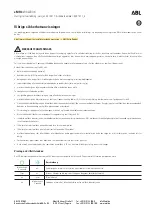
E-Series
15 of 20
User’s Manual
The charger requires minimal maintenance. It should be kept clean. Twice a year, or as often as the cleanliness
of the area may dictate, the interior of the charger should be thoroughly blown clean with dry compressed air.
The components of the charger are cooled by natural convection. If dust and debris are allowed to build up, they
will restrict airflow and could cause components to overheat.
Always be careful not to bump wiring or
components. This could cause loose connections and failures.
Moisture may cause electrical shorting and/or corrosion. It may also combine with dust and debris making them
more difficult to remove. Do not use liquids to clean the charger. Liquids could cause damage. Compressed air
should be used to clean dust and debris from the charger and its components.
12.1 Check Charger Area
The area around the charger must remain clean, cool, dry, and well ventilated. Check for obstructions to
airflow, clearances, or other violations of the requirements in Section 5.
12.2 Visual Inspections
Check the charger for any physical failures, such as loose contacts or hardware, excess wear, or damage.
Darkened or hot terminals should be tightened or replaced.
12.3 Battery Conditions
CAUTION: CHECK THE DC CONNECTIONS FROM THE CHARGER TO THE BATTERY AND MAKE
SURE THEY ARE TIGHT AND CLEAN. TIGHTEN AND/OR CLEAN IF NEEDED. FAILURE TO DO SO
COULD CAUSE MALFUNCTION, FIRE, OR EXPLOSION.
Batteries must be well maintained for the charging system to operate properly. Follow battery manufacturer
instructions for battery maintenance. Check for loose connections or corrosion.
DC connections may become corroded over time. If the connections become corroded, they should be
cleaned as recommended by the battery manufacturer. After the connections have been cleaned, a battery
connection treatment should be applied to help prevent corrosion from reoccurring. Contact the battery
manufacturer for their recommendations.
Periodic cleaning and watering of non-sealed batteries is very important. Logging the water usage of non-
sealed batteries is useful. As a battery ages, it will use more water.
13. TROUBLESHOOTING AND SERVICE
CAUTION: DO NOT DISASSEMBLE THE CHARGER. TAKE IT TO A QUALIFIED SERVICE TECHNICIAN
WHEN SERVICE OR REPAIR IS REQUIRED. INCORRECT REASSEMBLY MAY RESULT IN A RISK OF
ELECTRIC SHOCK OR FIRE.
DANGER: TO REDUCE THE RISK OF ELECTRIC SHOCK, ALWAYS DISCONNECT BOTH THE POWER
SUPPLY CORD AND THE OUTPUT CORD BEFORE ATTEMPTING ANY MAINTENANCE OR SERVICE.
WARNING: DO NOT OPERATE THE CHARGER IF IT IS MALFUNCTIONING. PERSONAL INJURY OR
PROPERTY DAMAGE COULD RESULT.
The charger was fully tested and calibrated before leaving the factory. It was delivered ready to charge. If
properly installed, the charger should require very little attention. If improper charger operation occurs, it will
require repair by a qualified service technician.
Содержание E - Series SCR
Страница 17: ...E Series 17 of 20 User s Manual WIRING DIAGRAM ...
Страница 19: ...E Series 19 of 20 User s Manual NOTES ...
Страница 20: ...E Series 20 of 20 User s Manual Represented By 37324G 37324 ...






































